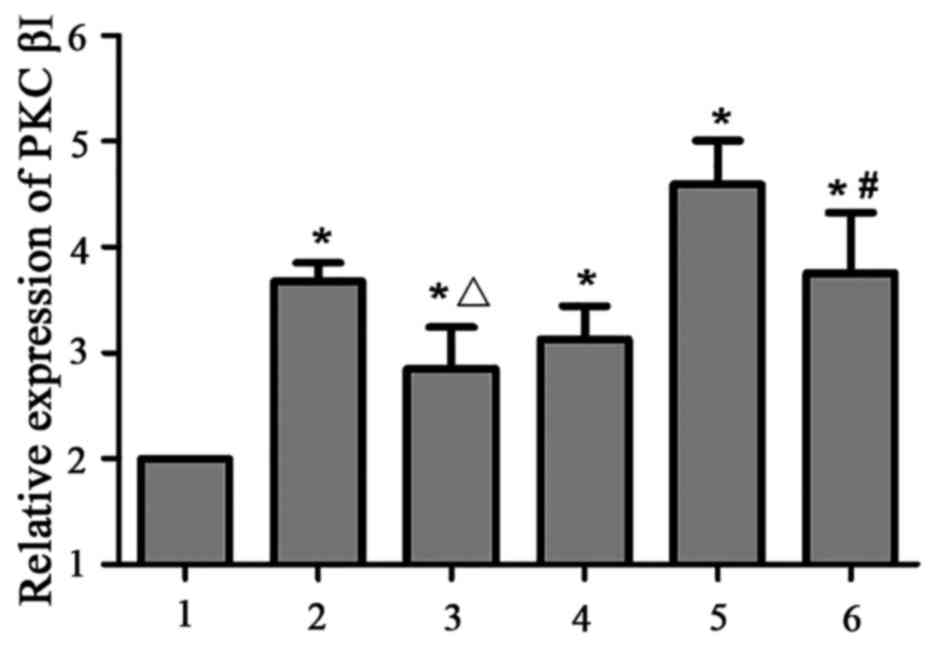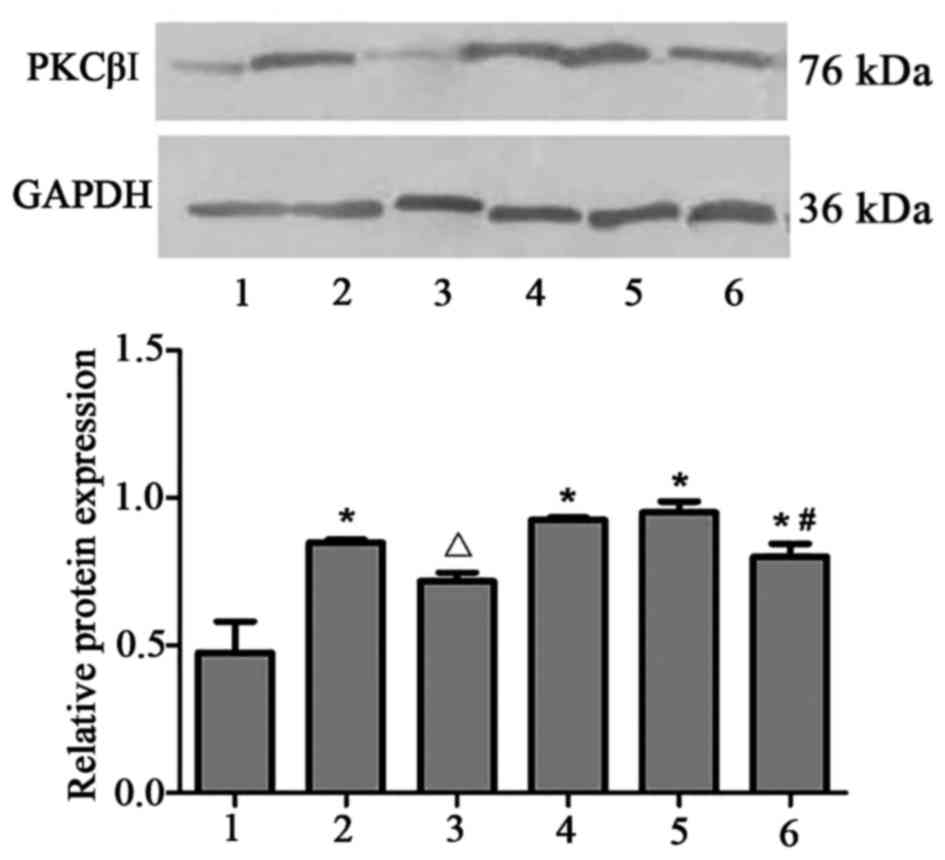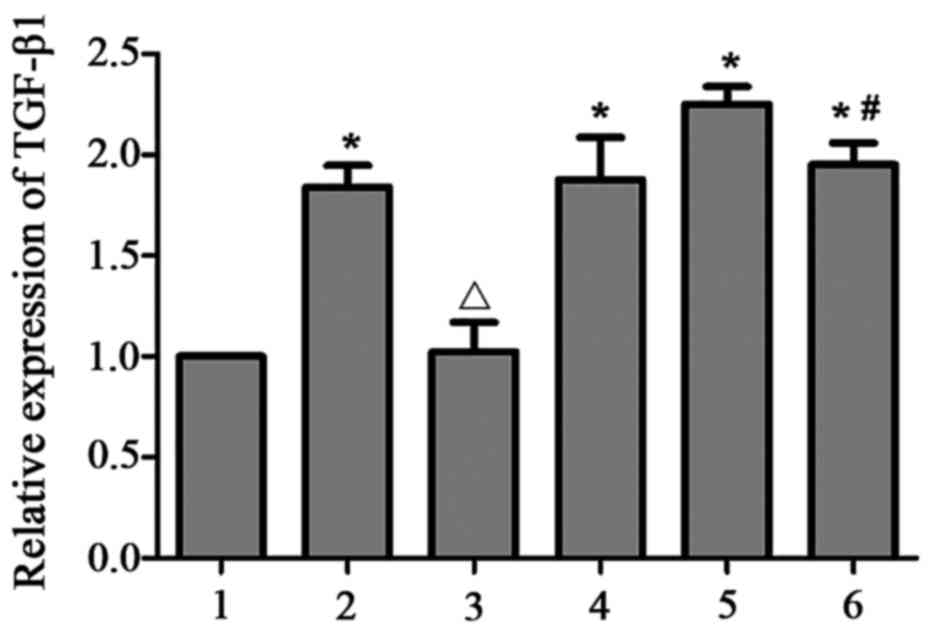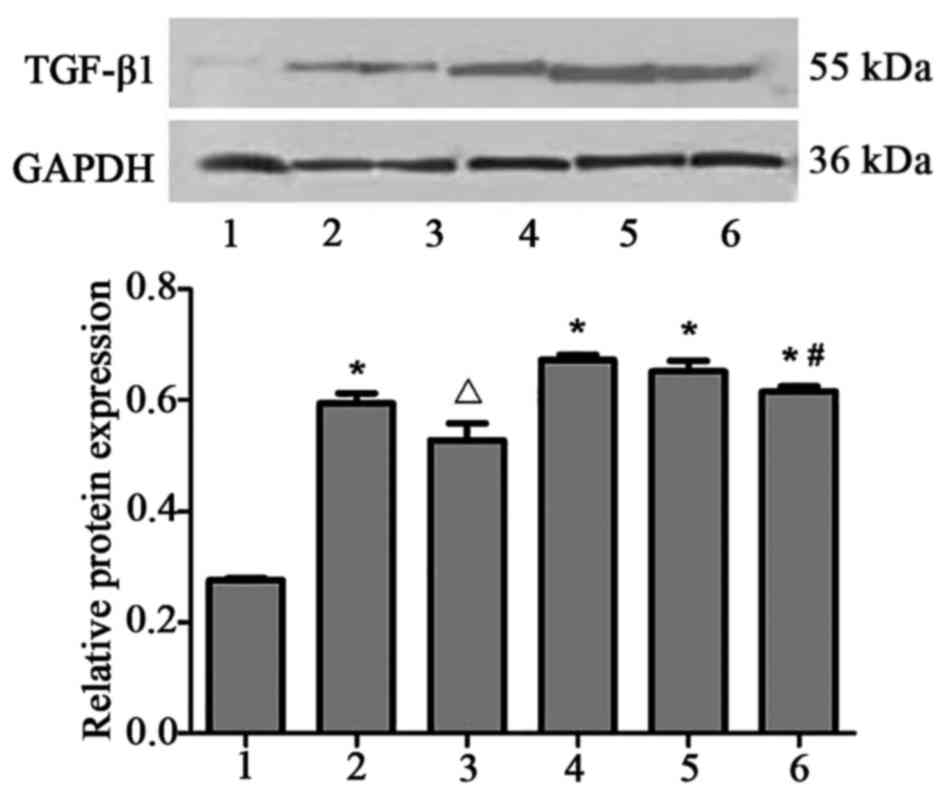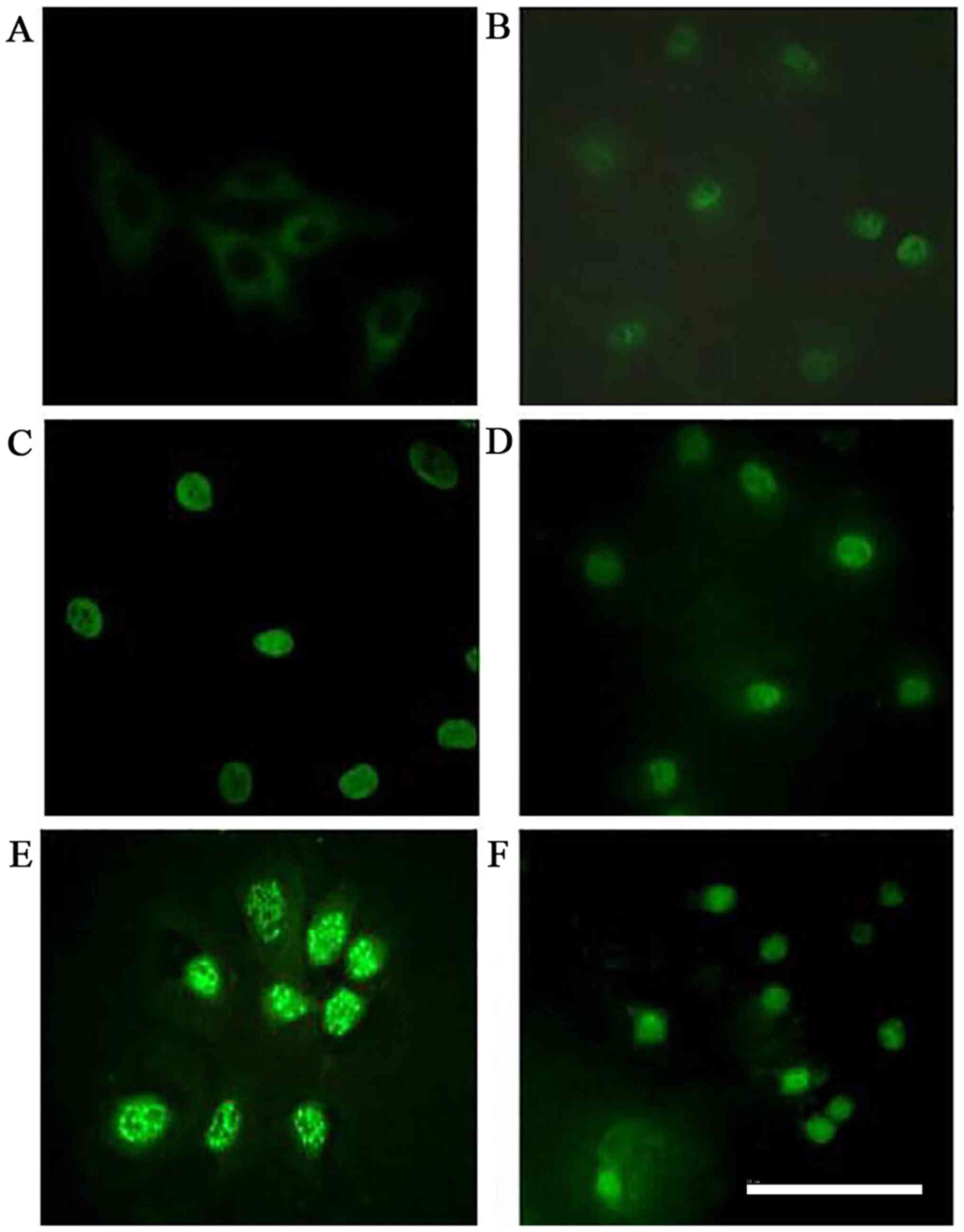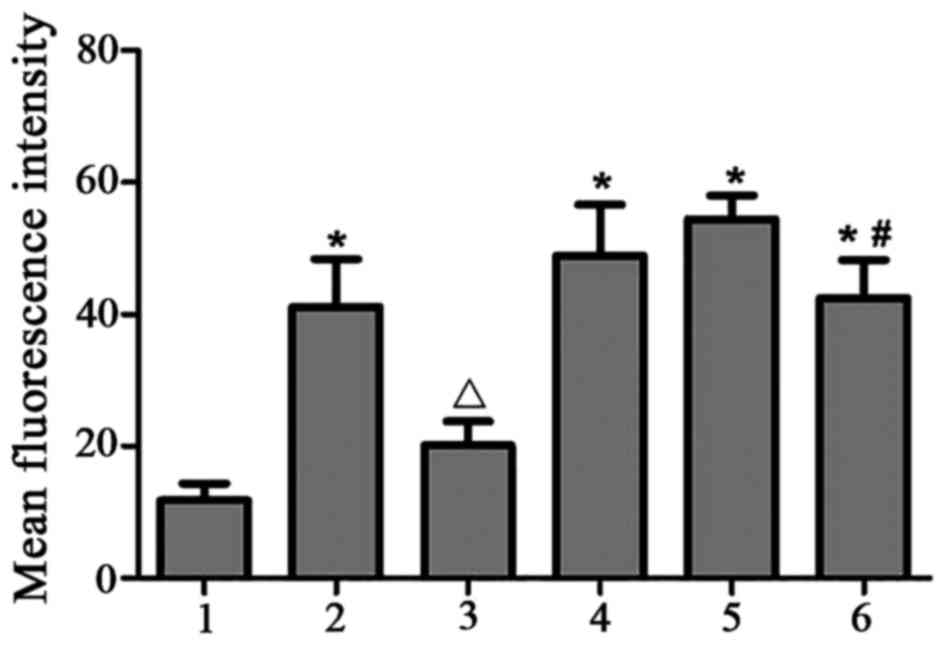High glucose/lysophosphatidylcholine levels stimulate extracellular matrix deposition in diabetic nephropathy via platelet‑activating factor receptor
- Authors:
- Published online on: November 20, 2017 https://doi.org/10.3892/mmr.2017.8102
- Pages: 2366-2372
-
Copyright: © Zhou et al. This is an open access article distributed under the terms of Creative Commons Attribution License.
Abstract
Introduction
Diabetic nephropathy (DN) is the leading cause of end-stage renal disease (ESRD) in diabetes, with an incidence of 20–40% worldwide (1,2). DN is characterized by progressive renal interstitial fibrosis. A previous study reported that high glucose (HG) and lysophosphatidylcholine (LPC) levels were associated with the development and progression of DN (3); these two factors have been demonstrated to stimulate platelet-activating factor (PAF) expression and extracellular matrix (ECM) secretion by the mesangial cells (MCs) of the kidney (4).
Protein kinase C (PKC)βI is an isoenzyme in the PKC family and is involved in a number of biological processes, including cell proliferation, differentiation, apoptosis and angiogenesis (5), in addition to having a role in the pathogenesis of DN (6,7). PKC is aberrantly activated in the diabetic kidney, which leads to an increase in PKCβI activity and deposition of ECM proteins, including fibronectin (Fn) and collagen (Col) type IV (8,9). In addition, transforming growth factor (TGF)-β1 has an important role in ECM accumulation during renal fibrosis (10), and it has been implicated in the occurrence of DN (11–13). However, the underlying molecular mechanism between PAF, PKC, TGF-β1 and the ECM in DN remains to be elucidated. The present study investigated the association among the aforementioned factors in a DN model consisting of human (H)MCs exposed to high HG) and LPC treatments. Reverse transcription-quantitative polymerase chain reaction and western blotting was used to detect PKCβI and TGF-β1 expression, and then an ELISA assay was used to detect the expression levels of the ECM-associated molecules collagen IV and fibronectin in the supernatant. To clarify the function of PKCβI, immunocytochemistry was used to demonstrated the subcellular localization of PKCβI. The results of the present study suggested that PAF stimulated ECM deposition in HMCs via activation of the PKC-TGF-β1 axis in a DN model.
Materials and methods
Cell culture
HMCs donated by the Zhongda Hospital affiliated with Southeast University (Nanjing, China) were maintained in Dulbecco's modified Eagle's medium containing 10% fetal calf serum (Invitrogen; Thermo Fisher Scientific, Inc., Waltham, MA, USA) in an atmosphere containing 5% CO2 at 37°C.
The cells were divided into six groups: Control (5.5 mM D-glucose; Enzo Life Sciences, Inc., Farmingdale, NY, USA); PAF (2×10−8 M PAF C-16; Cayman Chemical Company, Ann Arbor, MI, USA); PAF + PKCβI inhibitor LY333531 (Enzo Life Sciences, Inc.; 2×10−8 M PAF and 2×10−7 M LY333531); HG + LPC (Sigma-Aldrich; Merck KGaA, Darmstadt, Germany; 30 mM D-glucose and 20 mg/l LPC); PAF + HG + LPC (2×10−8 PAF, 30 mM D-glucose and 20 mg/l LPC); and PAF + HG + LPC + LY333531 (2×10−8 PAF, 30 mM D-glucose, 20 mg/l LPC and 2×10−7 M LY333531) (4).
ELISA analysis
The expression levels of Fn and Col IV in the cell culture supernatants were detected using specific ELISA kits (cat nos. CSB-EL005745HU and CSB-E04551h) according to the manufacturer's protocol (JingMei Biotech, Shenzheng, China). Samples were analyzed in triplicate.
Reverse transcription-quantitative polymerase chain reaction (RT-qPCR) analysis
Total RNA was isolated from cells using TRIzol reagent (Invitrogen; Thermo Fisher Scientific, Inc.) and was reverse transcribed into cDNA using the Revert Aid First Strand cDNA Synthesis kit (Fermentas; Thermo Fisher Scientific, Inc.), according to the manufacturer's protocol. RT-qPCR assay was performed using a SYBR_Premix ExTaq II kit (Takara Biotechnology Co., Ltd., Dalian, China) was performed using in the CFX96 Real-Time PCR Detection system (Bio-Rad Laboratories, Inc., Hercules, CA, USA) to determine the relative expression levels of target genes. The sequences of forward and reverse primers: PKCβI, 5′-GGGGGCGACCTCATGTAT-3′ and 5′-GCAATTTCTGCAGCGTAAAA-3′; and GAPDH, 5′-ACACCCACTCCTCCACCTTT-3′ and 5′-TTACTCCTTGGAGGCCATGT-3′. Primers were designed using Premier Oligo version 5 and Primer version 6.22 (Premier Biosoft International, Palo Alto, CA, USA). The thermocycling program used was as follows: 95°C for 30 sec, followed by 40 cycles of 60°C for 30 sec and 72°C for 30 sec. Relative changes in expression level were calculated using the quantification cycle (2−ΔΔCq) method (14). Each sample was prepared in triplicate and the results are expressed as the mean of three independent experiments.
Western blotting
Cells were resuspended in lysis buffer (Beijing Solarbio Science & Technology Co., Ltd., Beijing, China) for 30 min and sonicated for 2 min at 20 W, followed by centrifugation at 12,000 × g for 10 min at 4°C. The supernatant was collected and 50 µg/lane protein (concentration determined using the bicinchoninic assay kit (Thermo Fisher Scientific, Inc.) was separated using SDS-PAGE on a 10% gel (Bio-Rad Laboratories, Inc.) and transferred to a nitrocellulose membrane (Bio-Rad Laboratories, Inc.), which was blocked in Tris-buffered saline/Tween-20 (TBST) with 5% non-fat milk for 1 h at 37°C. The membrane was subsequently incubated with primary antibodies against TGF-β1 (cat no. sc-146; 1:2,000), PKCβI (cat no. sc- 209; 1:1,000) and GAPDH (cat no. sc-25778; 1:500) (both from Santa Cruz Biotechnology, Inc., Dallas, TX, USA) overnight at 4°C. Following washing with TBST, the membranes were incubated with a horseradish peroxidase-conjugated labeled goat anti-rabbit secondary antibody (cat no. sc-2004; 1:500; Santa Cruz Biotechnology, Inc.) for 1 h at 4°C, followed by additional three washes with TBST. Protein bands were visualized by enhanced chemiluminescence (GE Healthcare, Chicago, IL, USA). The Scion Image system version 4.03 (National Institutes of Health, Bethesda, MD, USA) was used to quantify band intensity and data are expressed as the mean of three independent experiments.
Immunocytochemistry
Cells (2×104/ml) were cultured on coverslips in 24-well plates for 24 h, and subsequently fixed with 4% paraformaldehyde for 5 min at −20°C and blocked at room temperature for 30 min in 0.2% Triton X-100 in PBS. The cells were incubated with anti-PKCβI antibody (1:50) (cat no. 07-870; EMD Millipore, Billerica, MA, USA) overnight at 4°C, followed by fluorescein isothiocyanate-conjugated secondary antibody (1:400; cat no. K532511-8; Dako; Agilent Technologies, Inc., Santa Clara, CA, USA) for 1 h in the dark at room temperature. Following three washes in PBS, coverslips were placed on the slides and the cells were visualized using confocal microscopy. Fluorescence intensity (wavelength of 490 nm) was analyzed using Image J software (version number: 1.48u; (National Institutes of Health).
Statistical analysis
Data are expressed as the mean ± standard error of the mean. Data were analyzed using SPSS software version 13.0 (SPSS, Inc., Chicago, IL, USA). Differences between groups were assessed using the Student's t-test. P<0.05 was considered to indicate a statistically significant difference.
Results
PKCβI expression is upregulated in HMCs in the presence of PAF, HG and LPC
PKCβI mRNA expression level was increased in the PAF, HG + LPC, and PAF + HG + LPC groups compared with control group (P<0.05). The expression was increased in the PAF + HG + LPC group compared with cells treated with HG and LPC alone (P<0.05), this increase in PKCβI expression was reversed by treatment with the PKCβI inhibitor LY333531 (P<0.05; Table I; Fig. 1).
A similar trend was observed for PKCβI protein expression, which was increased in the PAF, HG + LPC and PAF + HG + LPC groups compared with control cells (P<0.05; Fig. 2). The observed upregulation in PKCβI expression levels was reduced following treatment with LY333531 (P<0.05).
TGF-β1 expression is upregulated in HMCs in the presence of PAF, HG and LPC
TGF-β1 mRNA (Table II; Fig. 3) and protein (Fig. 4) expression levels were upregulated in HMCs treated with PAF, HG and LPC, compared with the control (P<0.05). The increased expression was not observed in the presence of LY333531.
ECM production is induced in HMCs in the presence of PAF, HG and LPC
The expression levels of two ECM proteins, Fn and Col IV, in the supernatant of cultured HMCs were significantly upregulated following treatment with PAF, HG and LPC, compared with the control group (P<0.05; Fig. 5), with increased levels observed in cells treated with all three factors compared with HG and LPC group (P<0.05). This effect was reduced following treatment with LY333531 (Table III).
Table III.Expression of the extracellular matrix components Fn and Col IV in the different treatment groups. |
PKCβI protein is translocated from the cytoplasm to the nucleus of HMCs following treatment with PAF, HG and LPC
In the control group, PKCβI was diffusely distributed throughout the cytoplasm, with no membrane or nuclear localization. Treatment with PAF, HG and LPC increased PKCβI protein levels, and induced the translocation of the protein from the cytoplasm to the nucleus(P<0.05). Treatment with LY333531 did not alter in the subcellular localization of PKCβI protein (Table IV; Figs. 6 and 7).
Table IV.Mean fluorescence intensity of PKCβI in human mesangial cells under various treatment conditions. |
Discussion
Diabetes mellitus is an important public health concern, especially in developed countries (15), with DN being the primary cause of ESRD worldwide (16–19). DN is caused by nerve damage resulting from ECM deposition, mesangial expansion and basement membrane thickening (20). The accumulation of Fn and Col IV underlies chronic kidney diseases, including progressive renal interstitial fibrosis (21). Metabolic disorders, such as hyperlipidemia and hyperglycemia, are associated with the occurrence and development of DN, with increased glucose and fat levels having an adverse effect on glomerular capillary endothelial cells and MCs, in addition to podocytes in the kidney (22), via stimulation of ECM secretion (23) mediated by TGF-β/mothers against decapentaplegic homolog 3 signaling. A HG/high fat diet may upregulate Fn and Col IV expression, which may alter the structure and function of renal tubules and lead to renal tubulointerstitial fibrosis (24). PAF is a lipid polymer, involved in the metabolism of arachidonic acid, that has a role in DN by stimulating Fn secretion (25). The present study determined that Fn and Col IV secretion were stimulated by PAF, HG and LPC, consistent with previous studies (8,26,27). The findings of the present study supported the hypothesis that HG and LPC may be risk factors for renal fibrosis and DN.
PKC is a serine/threonine kinase expressed in various mammalian tissues, which regulates a number of signaling pathways (28,29). The present study revealed that PKC was diffusely distributed throughout the cytoplasm in untreated HMCs and translocated to the nucleus in the presence of PAF, HG and LPC. DN may be delayed or prevented by inhibiting PKC (30,31); enlargement of kidney volume and renal fibrosis were rescued by PKCβI-knockout in a mouse model of DN (8). LY333531 is a Food and Drug Administration-approved inhibitor of PKC-Β (32), which has been demonstrated to promote myocardial angiogenesis in diabetes (33) and improve albuminuria and other pathological features in DN rats via inhibition of PKC expression (34). Treatment with LY333531 was demonstrated to reduce mesangial matrix expansion and decrease the urinary protein excretion rate in diabetic mice (35). In the present study, LY333531 treatment prevented the nuclear localization of PKCβI protein in the presence of PAF, HG and LPC, which corresponded to the decrease in Fn and Col IV secretion. The findings of the present study suggested that PKCβI may have an important role in ECM deposition by HMCs in DN.
TGF-β1 is a TGF-β superfamily member which regulates a variety of cellular processes, including proliferation, differentiation and apoptosis (36,37). TGF-β1 has an important role in kidney hypertrophy (26), glomerular and renal tubular basement membrane thickening, and renal tubulointerstitial fibrosis (38,39), and previous studies have suggested that it may modulate ECM secretion in DN. For example, plasmacytoma variant translocation 1 was demonstrated to increase plasminogen TGF-β1 in addition to Fn expression in MCs (40), whereas TGF-β1 inhibited the expression of microRNA (miR)-26a to modulate DN progression in diabetic mice (41). ECM accumulation was increased via upregulation of miR-1207-5p in the presence of glucose and TGF-β1, which was implicated in DN pathogenesis (42). Additionally, Fn and Col IV levels were suppressed by the knockdown of TGF-β1 (43). The present study revealed that TGF-β1 mRNA and protein expression levels were upregulated in HMCs, following treatment with PAF, HG and LPC compared with the control group, which was accompanied by increased Fn and Col IV secretion; these effects were abolished by treatment with LY333531.
In conclusion, the findings of the present study suggested that ECM deposition by MCs may be induced by HG and LPC treatment and activation of PKCβI–TGF-β1 signaling via PAF. Increased ECM deposition increases the risk of glomerular fibrosis and DN in individuals with disorders of glucose and lipid metabolism. The present findings reveal novel strategies for managing DN by targeting the PKC-TGF-β1 signaling pathway in MCs.
Acknowledgements
The authors of the present study would like to thank the Research Center of Guilin Medical University, and the laboratory staff for their assistance. The present study was supported by the National Natural Science Foundation of China (grant nos. 81260134 and 81560148).
References
|
Schernthaner G, Mogensen CE and Schernthaner GH: The effects of GLP-1 analogues, DPP-4 inhibitors and SGLT2 inhibitors on the renal system. Diab Vasc Dis Res. 11:306–323. 2014. View Article : Google Scholar : PubMed/NCBI | |
|
Zhang MH, Feng L, Zhu MM, Gu JF, Jiang J, Cheng XD, Ding SM, Wu C and Jia XB: The anti-inflammation effect of Moutan Cortex on advanced glycation end products-induced rat mesangial cells dysfunction and High-glucose-fat diet and streptozotocin-induced diabetic nephropathy rats. J Ethnopharmacol. 151:591–600. 2014. View Article : Google Scholar : PubMed/NCBI | |
|
Xie S, Lu K, Zhang Y, Song X, Tan M and Wang C: Effects of Jiangya Xiaoke prescription on TGF-beta1 in diabetic nephropathy rats with hypertension and its mechanisms. Int J Clin Exp Med. 8:5129–5136. 2015.PubMed/NCBI | |
|
Zhou SX, Lei MX and Zhao JJ: The study of the effects of platelet activating factor (PAF) on the relation between the endothelial cell and mesangial cells exposed to high glucose and high lysophosphatidylcholine. Chin J Diabetes. 18:591–593. 2010.(In Chinese). | |
|
Al-Khodor S and Abu KY: Triggering Ras signalling by intracellular Francisella tularensis through recruitment of PKCalpha and betaI to the SOS2/GrB2 complex is essential for bacterial proliferation in the cytosol. Cell Microbiol. 12:1604–1621. 2010. View Article : Google Scholar : PubMed/NCBI | |
|
Noh H and King GL: The role of protein kinase C activation in diabetic nephropathy. Kidney Int Suppl. S49–S53. 2007. View Article : Google Scholar : PubMed/NCBI | |
|
Bryant DM, Roignot J, Datta A, Overeem AW, Kim M, Yu W, Peng X, Eastburn DJ, Ewal AJ, Werb Z and Mostov KE: A molecular switch for the orientation of epithelial cell polarization. Dev Cell. 31:171–187. 2014. View Article : Google Scholar : PubMed/NCBI | |
|
Meier M, Park JK, Overheu D, Kirsch T, Lindschau C, Gueler F, Leitges M, Menne J and Haller H: Deletion of protein kinase C-beta isoform in vivo reduces renal hypertrophy but not albuminuria in the streptozotocin-induced diabetic mouse model. Diabetes. 56:346–354. 2007. View Article : Google Scholar : PubMed/NCBI | |
|
Idris I and Donnelly R: Protein kinase C beta inhibition: A novel therapeutic strategy for diabetic microangiopathy. Diab Vasc Dis Res. 3:172–178. 2006. View Article : Google Scholar : PubMed/NCBI | |
|
Muñoz-Felix JM, Oujo B and Lopez-Novoa JM: The role of endoglin in kidney fibrosis. Expert Rev Mol Med. 16:e182014. View Article : Google Scholar : PubMed/NCBI | |
|
Wang T, Chen SS, Chen R, Yu DM and Yu P: Reduced beta 2 glycoprotein I improves diabetic nephropathy via inhibiting TGF-β1-p38 MAPK pathway. Int J Clin Exp Pathol. 8:2321–2333. 2015.PubMed/NCBI | |
|
Hathaway CK, Gasim AM, Grant R, Chang AS, Kim HS, Madden VJ, Bagnell CR Jr, Jennette JC, Smithies O and Kakoki M: Low TGFβ1 expression prevents and high expression exacerbates diabetic nephropathy in mice. Proc Natl Acad Sci USA. 112:pp. 5815–5820. 2015; View Article : Google Scholar : PubMed/NCBI | |
|
Gao P, Li L, Ji L, Wei Y, Li H, Shang G, Zhao Z, Chen Q, Jiang T and Zhang N: Nrf2 ameliorates diabetic nephropathy progression by transcriptional repression of TGFβ1 through interactions with c-Jun and SP1. Biochim Biophys Acta. 1839:1110–1120. 2014. View Article : Google Scholar : PubMed/NCBI | |
|
Livak KJ and Schmittgen TD: Analysis of relative gene expression data using real-time quantitative PCR and the 2(-Delta Delta C(T)) method. Methods. 25:402–408. 2001. View Article : Google Scholar : PubMed/NCBI | |
|
Duan JG, Chen XY, Wang L, Lau A, Wong A, Thomas GN, Tomlinson B, Liu R, Chan JC, Leung TW, et al: Sex differences in epidemiology and risk factors of acute coronary syndrome in Chinese patients with type 2 diabetes: A long-term prospective cohort study. PLoS One. 10:e1220312015. View Article : Google Scholar | |
|
Bakris GL, Pitt B, Weir MR, Freeman MW, Mayo MR, Garza D, Stasiv Y, Zawadzki R, Berman L and Bushinsky DA: AMETHYST-DN Investigators: Effect of patiromer on serum potassium level in patients with hyperkalemia and diabetic kidney disease: The AMETHYST-DN randomized clinical trial. JAMA. 314:151–161. 2015. View Article : Google Scholar : PubMed/NCBI | |
|
Panduru NM, Saraheimo M, Forsblom C, Thorn LM, Gordin D, Wadén J, Tolonen N, Bierhaus A, Humpert PM and Groop PH; FinnDiane Study Group, : Urinary adiponectin is an independent predictor of progression to end-stage renal disease in patients with type 1 diabetes and diabetic nephropathy. Diabetes Care. 38:883–890. 2015. View Article : Google Scholar : PubMed/NCBI | |
|
De Nicola L, Provenzano M, Chiodini P, Borrelli S, Garofalo C, Pacilio M, Liberti ME, Sagliocca A, Conte G and Minutolo R: Independent role of underlying kidney disease on renal prognosis of patients with chronic kidney disease under nephrology care. PLoS One. 10:e1270712015. View Article : Google Scholar | |
|
Liu X, Yang G, Fan Q and Wang L: Proteomic profile in glomeruli of type-2 diabetic KKAy mice using 2-dimensional differential gel electrophoresis. Med Sci Monit. 20:2705–2713. 2014. View Article : Google Scholar : PubMed/NCBI | |
|
Abe H: Recent progress in understanding the molecular pathogenesis of diabetic nephropathy. Rinsho Byori. 59:179–186. 2011.(In Japanese). PubMed/NCBI | |
|
Rossert J, Terraz-Durasnel C and Brideau G: Growth factors, cytokines, and renal fibrosis duringthe course of diabetic nephropathy. Diabetes Metab. 26 Suppl 4:S16–S24. 2000. | |
|
Zhou L: Research progress in impact of high glucose and hyperlipidemia on glomerular cells. New Med. 286–289. 2014.(In Chinese). | |
|
Li L, Yin Q, Tang X, Bai L, Zhang J, Gou S, Zhu H, Cheng J, Fu P and Liu F: C3a receptor antagonist ameliorates inflammatory and fibrotic signals in type 2 diabetic nephropathy by suppressing the activation of TGF-β/smad3 and IKBα pathway. PLoS One. 9:e1136392014. View Article : Google Scholar : PubMed/NCBI | |
|
Li HG, Cai YJ and Zou JH: The effects of high-gucrose and high-fat diet on tubulointerstitial fibrosis in New Zanland white rabbits. Chinese J Zoology. 145–150. 2010.(In Chinese). | |
|
Yoshikawa M, Matsumoto K, Iida M, Akasawa A, Moriyama H and Saito H: Effect of extracellular matrix proteins on platelet-activating factor-induced eosinophil chemotaxis. Int Arch Allergy Immunol. 128 Suppl 1:S3–S11. 2002. View Article : Google Scholar | |
|
Yao LJ, Wang JQ, Zhao H, Liu JS and Deng AG: Effect of telmisartan on expression of protein kinase C-alpha in kidneys of diabetic mice. Acta Pharmacol Sin. 28:829–838. 2007. View Article : Google Scholar : PubMed/NCBI | |
|
Wogensen L, Krag S, Chai Q and Ledet T: The use of transgenic animals in the study of diabetic kidney disease. Horm Metab Res. 37 Suppl 1:S17–S25. 2005. View Article : Google Scholar | |
|
Mishra S and Vinayak M: Ellagic acid checks lymphoma promotion via regulation of PKC signaling pathway. Mol Biol Rep. 40:1417–1428. 2013. View Article : Google Scholar : PubMed/NCBI | |
|
do Carmo A, Balça-Silva J, Matias D and Lopes MC: PKC signaling in glioblastoma. Cancer Biol Ther. 14:287–294. 2013. View Article : Google Scholar : PubMed/NCBI | |
|
Manabe E, Handa O, Naito Y, Mizushima K, Akagiri S, Adachi S, Takagi T, Kokura S, Maoka T and Yoshikawa T: Astaxanthin protects mesangial cells from hyperglycemia-induced oxidative signaling. J Cell Biochem. 103:1925–1937. 2008. View Article : Google Scholar : PubMed/NCBI | |
|
Ochi S, Harigai M, Mizoguchi F, Iwai H, Hagiyama H, Oka T and Miyasaka N: Leflunomide-related acute interstitial pneumonia in two patients with rheumatoid arthritis: Autopsy findings with a mosaic pattern of acute and organizing diffuse alveolar damage. Mod Rheumatol. 16:316–320. 2006. View Article : Google Scholar : PubMed/NCBI | |
|
Schwartz SG, Flynn HW Jr and Aiello LP: Ruboxistaurin mesilate hydrate for diabetic retinopathy. Drugs Today (Barc). 45:269–274. 2009. View Article : Google Scholar : PubMed/NCBI | |
|
Wang F, Huang D, Zhu W, Li S, Yan M, Wei M and Li J: Selective inhibition of PKCbeta2 preserves cardiac function after myocardial infarction and is associated with improved angiogenesis of ischemic myocardium in diabetic rats. Int J Mol Med. 32:1037–1046. 2013. View Article : Google Scholar : PubMed/NCBI | |
|
Kelly DJ, Zhang Y, Hepper C, Gow RM, Jaworski K, Kemp BE, Wilkinson-Berka JL and Gilbert RE: Protein kinase C beta inhibition attenuates the progression of experimental diabetic nephropathy in the presence of continued hypertension. Diabetes. 52:512–518. 2003. View Article : Google Scholar : PubMed/NCBI | |
|
Koya D, Haneda M, Nakagawa H, Isshiki K, Sato H, Maeda S, Sugimoto T, Yasuda H, Kashiwagi A, Ways DK, et al: Amelioration of accelerated diabetic mesangial expansion by treatment with a PKC beta inhibitor in diabetic db/db mice, a rodent model for type 2 diabetes. FASEB J. 14:439–447. 2000.PubMed/NCBI | |
|
Hinz B: The extracellular matrix and transforming growth factor-β1: Tale of a strained relationship. Matrix Biol. 47:54–65. 2015. View Article : Google Scholar : PubMed/NCBI | |
|
Kajdaniuk D, Marek B, Borgiel-Marek H and Kos-Kudła B: Transforming growth factor β1 (TGFβ1) in physiology and pathology. Endokrynol Pol. 64:384–396. 2013. View Article : Google Scholar : PubMed/NCBI | |
|
Huang W, Xu C, Kahng KW, Noble NA, Border WA and Huang Y: Aldosterone and TGF-beta1 synergistically increase PAI-1 and decrease matrix degradation in rat renal mesangial and fibroblast cells. Am J Physiol Renal Physiol. 294:F1287–F1295. 2008. View Article : Google Scholar : PubMed/NCBI | |
|
Sam R, Wanna L, Gudehithlu KP, Garber SL, Dunea G, Arruda JA and Singh AK: Glomerular epithelial cells transform to myofibroblasts: Early but not late removal of TGF-beta1 reverses transformation. Transl Res. 148:142–148. 2006. View Article : Google Scholar : PubMed/NCBI | |
|
Alvarez ML and DiStefano JK: Functional characterization of the plasmacytoma variant translocation 1 gene (PVT1) in diabetic nephropathy. PLoS One. 6:e186712011. View Article : Google Scholar : PubMed/NCBI | |
|
Koga K, Yokoi H, Mori K, Kasahara M, Kuwabara T, Imamaki H, Ishii A, Mori KP, Kato Y, Ohno S, et al: MicroRNA-26a inhibits TGF-β-induced extracellular matrix protein expression in podocytes by targeting CTGF and is downregulated in diabetic nephropathy. Diabetologia. 58:2169–2180. 2015. View Article : Google Scholar : PubMed/NCBI | |
|
Alvarez ML, Khosroheidari M, Eddy E and Kiefer J: Role of microRNA 1207-5P and its host gene, the long non-coding RNA Pvt1, as mediators of extracellular matrix accumulation in the kidney: Implications for diabetic nephropathy. PLoS One. 8:e774682013. View Article : Google Scholar : PubMed/NCBI | |
|
Hwang M, Kim HJ, Noh HJ, Chang YC, Chae YM, Kim KH, Jeon JP, Lee TS, Oh HK, Lee YS and Park KK: TGF-beta1 siRNA suppresses the tubulointerstitial fibrosis in the kidney of ureteral obstruction. Exp Mol Pathol. 81:48–54. 2006. View Article : Google Scholar : PubMed/NCBI |



